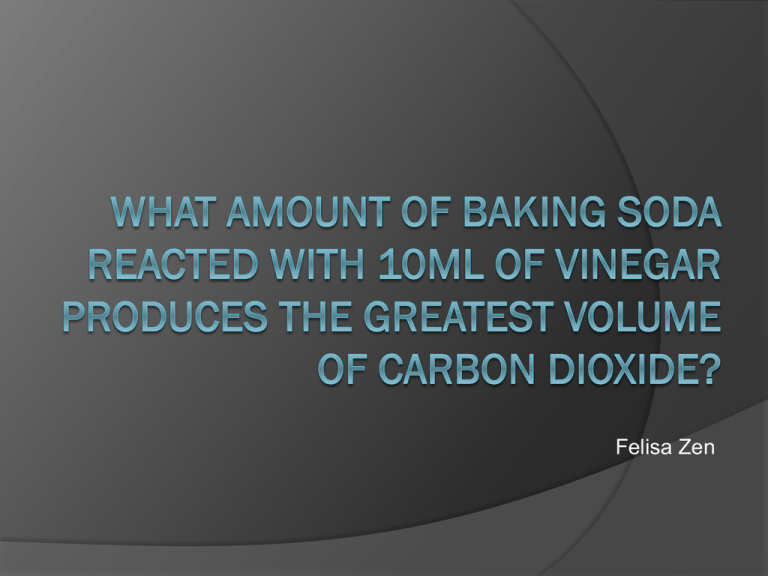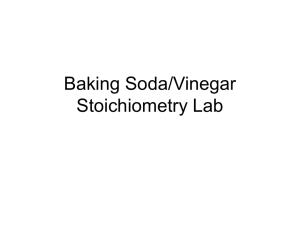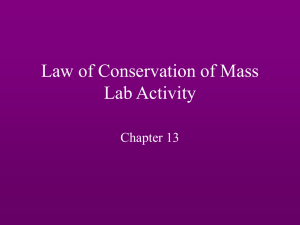Baking Soda & Vinegar Reaction: CO2 Volume Experiment
advertisement

Felisa Zen Aim To find out what mass of baking soda reacted with 10mL of vinegar will produce the greatest volume of carbon dioxide in a 100mL eudiometer tube Background information Baking soda is a base scientifically known as sodium bicarbonate NaHCO3 Vinegar is dilute acetic acid CH3COOH When sodium bicarbonate and acetic acid are reacted, they produce a double displacement acid-base reaction Chemical Equation NaHCO3(aq) + CH3COOH(aq) NaCH3COO(aq) + H2CO3(aq) NaCH3COO is a salt known as sodium acetate H2CO3 is an unstable carbonic acid which quickly decomposes and breaks down into H2O and CO2 Therefore, after the decomposition, the reaction would look like this: NaHCO3(aq) + CH3COOH(aq) NaCH3COO(aq) + H2O(l) + CO2(g) What actually happens? The acetic acid reacts with the basic sodium bicarbonate carbonic acid Carbonic acid carbon dioxide and water “eruption” (foaming, bubbling, fizzing, crackling) from CO2 escaping the reacted solution Only component left in the container: dilute solution of sodium acetate in water ○ NaCH3COO Hypothesis After Calculations 10mL of acetic acid v = 0.010L c = 0.5M n = 0.005moles NaHCO3(aq) + CH3COOH(aq) NaCH3COO(aq) + H2O(l) + CO2(g) Sodium bicarbonate n = 0.005moles (same number of moles as acetic acid) M = 23+1+12+(3)16 = 84g mol-1 m = 0.42g This should be the mass of sodium bicarbonate needed to react with 10mL of acetic acid to produce the greatest volume of carbon dioxide Table 1: Volume of Carbon Dioxide Produced by the Different Quantities of Baking Soda Reacted with 10mL of Vinegar Mass of NaHCO3 Volume of CH3COOH Volume of CO2 (g ± 0.001) (mL ± 0.01) (mL ± 0.1) Trial 1 4.039 10.00 84.3 Trial 2 3.028 10.00 86.8 Trial 3 2.062 10.00 88.4 Trial 4 1.050 10.00 91.9 Trial 5 0.520 10.00 95.6 Trial 6 0.437 10.00 84.5 Trial 7 0.350 10.00 81.3 Table 2: Observations of Carbon Dioxide Produced by 10mL of Vinegar Reacted with Different Quantities of Baking Soda Mass of NaHCO3 (g) Observations 4.039 One large gas bubble rises, followed by a train of gas bubbles rising up steadily into the eudiometer tube, one after another 3.028 One large gas bubble rises, followed by a train of gas bubbles rising up steadily into the eudiometer tube, one after another 2.062 One large gas bubble rises, followed by a train of gas bubbles rising up steadily into the eudiometer tube, one after another 1.050 One large gas bubble rises, then more gas bubbles rise up steadily but at a faster pace than the previous mass of baking soda (2g) 0.520 One large gas bubble rises, then more gas bubbles rise up even faster than the previous mass of baking soda (1g) 0.437 One large gas bubble rises, followed by a train of gas bubbles rising up steadily into the eudiometer tube, one after another, similar to the trial with 4g of baking soda 0.350 On large gas bubble rises, followed by a train of gas bubbles rising up steadily into the eudiometer tube, one after another, at a slower pace than all previous trials Graph 1: Volume of CO2 (mL) Produced by the Reaction Between Baking Soda (NaHCO3) and Vinegar (CH3COOH) Processing Data n=m/M Calculations for moles of NaHCO3 ○ Trial 1: 4.039/84 = 0.04808mol ○ Trial 2: 3.028/84 = 0.03605mol ○ Trial 3: 2.062/84 = 0.02455mol ○ Trial 4: 1.050/84 = 0.01250mol ○ Trial 5: 0.520/84 = 0.00619mol ○ Trial 6: 0.437/84 = 0.00520mol ○ Trial 7: 0.350/84 = 0.00417mol Calculations for moles of CH3COOH ○ All Trials: 10.00/60 = 0.1667mol Graph 2: Comparing Ratios Between Different Moles of Baking Soda Based on Its Mass to Moles of Vinegar 0.35 0.3 Moles 0.25 0.2 0.15 0.1 0.05 0 0.35 0.437 Baking Soda(mol) 0.52 1.05 2.062 Mass of Baking Soda(g) Vinegar(mol) Ratio of Baking Soda(mol) to Vinegar(mol) 3.028 4.039 Sample Calculations of Errors and Uncertainties for the Reaction Between 0.520g of NaHCO3 and 10mL of CH3COOH Percent Uncertainty (0.001/0.520)*100 = 19.23% (0.1/95.6)*100 = 10.46% 19.23+10.46 = 29.69% ≈ 30% Percent Error Experimental value ○ 95.6mL of CO2 Theoretical value ○ 1mole = 24.5L ○ 0.00619mole = 0.152L ○ 0.152L = 152mL ○ ((152-95.6)/152)*100 = 37.11% ≈ 37% Conclusion Increasing trend line: suggests that masses of baking soda below 0.5g increases rapidly in carbon dioxide production until it reaches 0.5g Decreasing trend line: suggests that from the highest point of carbon dioxide production (with 0.5g of baking soda) onwards, the production of carbon dioxide from the reaction into the eudiometer tube decreases steadily as the mass of baking soda is increased Theoretical calculations under “Processing Data” indicate that the results of the experiment support the calculated and compared molar ratios of baking soda to vinegar, however, the pattern in the production of carbon dioxide from the reaction between baking soda and vinegar is flipped when graphed for the ratios of different masses of baking soda to vinegar. This signifies that the greater the molar ratio of baking soda to vinegar, the lower the production of carbon dioxide during the reaction between baking soda and vinegar will be Evaluations Accuracy and precision in measurements of baking soda and vinegar It was difficult to get the accurate mass of baking soda to 3 decimal places through the electronic beam balance The vinegar was measured using a 25mL graduated cylinder, so the volume of vinegar was estimated merely through judgment of the naked eyes and is not very accurate nor precise The surface area of baking soda was not controlled There was a delay in the capturing of gas into the eudiometer tube As the quantity of baking soda decreased, it got progressively trickier to simultaneously mind the pouring of the entire quantity of baking soda into the conical flask while minding the escape of gas released by the already started reaction of baking soda to vinegar as the baking soda meets the vinegar through contact little by little before the bung is attached to the flask, which resulted in the spilling of baking soda By the time the amount of baking soda progressively decreased to a mass below 1.000g, perhaps due to the most reactive point of the reaction between baking soda and vinegar being in the very beginning of the reaction, and with the attachment of the bung to the conical flask being delayed, not all the gas produced by the reaction went into the eudiometer tube (especially in the beginning of the reaction), which may have produced inaccuracy in the recorded volume of carbon dioxide released into the eudiometer tube Evaluations In order to keep the surface area of baking soda a control in the experiment, use a spatula or a stirring rod to crush the baking soda into powder completely, leaving absolutely no clumps left In order to prevent from having too much gas escaping the reaction before the conical flask is connected to the eudiometer tube, have a partner ready to attach the bung into the opening of the conical flask without delay after the respective mass of baking soda is poured into the conical flask with 10mL of vinegar In order to get a more accurate measurement to keep the volume of vinegar a control in the experiment, use a pipette to measure 10mL of vinegar rather than a 25mL graduated cylinder In order to get a more accurate measurement of baking soda throughout the experiment, use a spatula to control the three decimal places in the mass of baking soda being weighed on the electronic beam balance by adding or taking out very small amounts of baking soda from the container it is being weighed on Works Cited Admin, Madsci. "Baking Soda Volcano." MadSciNet: The 24-hour Exploding Laboratory. Enigma Engines, 28 Jan. 1997. Web. 13 May 2010. <http://www.madsci.org/experiments/archive/854444893.Ch.ht mL>. "Baking Soda and Vinegar Reaction and Demonstrations." Apple Cider Vinegar Benefits. 2004. Web. 13 May 2010. <http://www.apple-cider-vinegar-benefits.com/baking-soda-andvinegar.htmL>. Schultz, Joe. "Vinegar and Baking Soda." NEWTON: Ask A Scientist. Argonne National Laboratory. Web. 13 May 2010. <http://www.newton.dep.anl.gov/askasci/chem99/chem99096.ht m>. "Vinegar + Baking Soda Explanation." Oracle ThinkQuest Library. Web. 13 May 2010. <http://library.thinkquest.org/3347/vinegar+bsoda4.htmL>.








